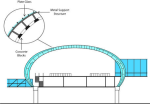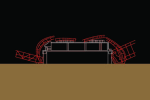Architecture Firm: Aéroports de Paris or ADP (Paul Andreu)
Construction Firm: Watson and Bredy, BESIX, HERVE and Léon Grosse,
Structural Engineering Firm: Sechaud et Bossuyt
[a]
Aéroport de Charles de Gaulle is the largest airport in Paris, France and the second busiest airport in all of Europe after London Heathrow. It covers an area of about 8,000 acres, and has three major terminals. Terminal 2 was the largest of the three terminals, with 2E, the newest addition, designed to be the “the most powerful hub in Europe, ahead of Frankfurt and London”. [b]
Leading the exciting 750M euro expansion to the terminal was the legendary French airport architect, Paul Andreu, who had designed the rest of CDG. It received rave reviews upon its inauguration for its “daring design and wide open spaces” and was called the “crown jewel of the CDG”. [c]
However, about eleven months after its inauguration on 23 May 2004, a substantial portion (about 30m) of the curved ceiling fell, killing four and injuring three travelers. The scene was described as “cataclysmic, like an earthquake”. [b]
Experts, at first, were unsure as to the cause of the collapse, considering that it had just been praised for its unique steel and glass design eleven months ago. Only later did it become clear that it was a combination of several factors that contributed to the disaster. [d]
One of the main factors that prompted the collapse was that the design for the building had very little margin for safety, so the construction process had to minutely exact in order for the building to be successful. [e]
The curved ceiling had three layers: an outer layer of glass, a middle layer consisting of a metal support structure, with the third layer being the concrete blocks that supported the metal and glass. It was found that the metal support structure was too deeply embedded in the concrete blocks, which caused cracking within the concrete, weakening the entire structure. It also placed a lot of tension on the outer layer in order to maintain stability. [b]
The architect, Paul Andreu, also blamed the construction company for not mixing and preparing the reinforced concrete properly, leading to its collapse. It was also found that rapid thermal expansion might have had an influence in causing the collapse, as in that particular day the temperature dropped substantially (from 25C to 4C). [e] [b]
The collapse of the “crown jewel” of the CDG was seen as a massive embarrassment to France in the international community as well as for the architect Paul Andreu. The terminal reopened again in 2008, after a 100M euro project to replace all the glass and steel with concrete in order to insure the same problems would not happen again. [c]



